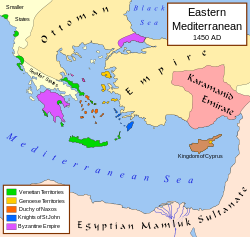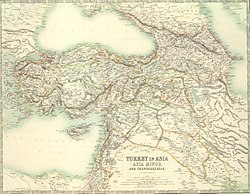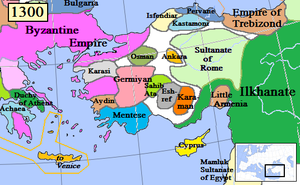
Back إمارة قرمان Arabic Karamánidas AST Qaramanoğulları bəyliyi Azerbaijani Карамания Bulgarian কারামান বেয়লিক Bengali/Bangla Beilicat dels karamànides Catalan Karamanovci Czech Karaman (Beylik) German Karamánidas Spanish قرامانیان Persian
This article needs additional citations for verification. (June 2011) |
Beylik of Karaman | |||||||||
|---|---|---|---|---|---|---|---|---|---|
| 1250–1487 | |||||||||
 The Karamanid beylik and other eastern Mediterranean states in 1450 | |||||||||
| Status | Beylik | ||||||||
| Capital | Larende Ermenek Konya (1307–1468) Mut Ereğli[1] | ||||||||
| Common languages | Persian, Old Anatolian Turkish[a] | ||||||||
| Religion | Sunni Islam | ||||||||
| Government | Monarchy | ||||||||
| Bey | |||||||||
• 1256? | Karaman Bey | ||||||||
• 1483–1487 | Mahmud Bey | ||||||||
| Historical era | Late Medieval | ||||||||
• Established | 1250 | ||||||||
• Disestablished | 1487 | ||||||||
| |||||||||
| History of Turkey |
|---|
 |
| Timeline |
|
|

The Karamanids (Turkish: Karamanoğulları or Karamanoğulları Beyliği), also known as the Emirate of Karaman and Beylik of Karaman (Turkish: Karamanoğulları Beyliği), was an Anatolian beylik of Salur tribe origin, centered in South-Central Anatolia around the present-day Karaman Province. From the mid 14th century until its fall in 1487, the Karamanid dynasty was one of the most powerful beyliks in Anatolia.[3]
- ^ Türk Tarih Sitesi, Türk Tarihi, Genel Türk Tarihi, Türk Cumhuriyetleri, Türk Hükümdarlar – Tarih Archived 24 July 2011 at the Wayback Machine
- ^ Green 2019, p. 62.
- ^ Ágoston, Gábor; Masters, Bruce Alan (2009). Encyclopedia of the Ottoman Empire. Infobase Publishing. p. 40. ISBN 9781438110257.
Cite error: There are <ref group=lower-alpha> tags or {{efn}} templates on this page, but the references will not show without a {{reflist|group=lower-alpha}} template or {{notelist}} template (see the help page).